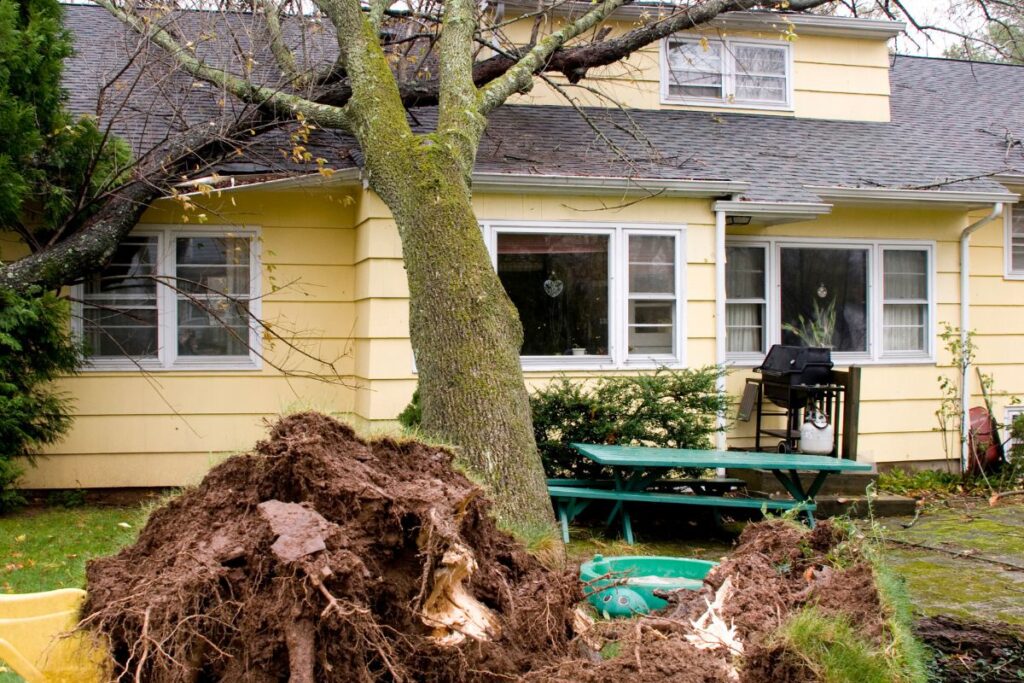
Tree Falls on Your House? What to Do and Who’s Responsible?

It’s a scary moment—strong winds or a storm knock over a tree, and it crashes onto your home. Naturally, the first question is:
Will insurance cover this?
And the second:
Who’s responsible for the damage—me or someone else?
1. Yes—Homeowners’ Insurance Usually Covers It
In most cases, standard homeowners’ insurance does cover damage caused by a falling tree. This includes:
- Damage to your roof, walls, or structure
- Broken windows
- Some belongings are inside your home
This is true whether the tree was healthy or not, as long as it fell due to a covered event like:
- A windstorm
- Lightning
- Heavy snow or ice
- Hail
Example: If a healthy tree in your yard falls on your house during a storm, your homeowners’ insurance will likely cover the cost of repairs (after you pay your deductible).
2. What If the Tree Was From My Neighbor’s Yard?
This is a common situation—and the good news is:
Your insurance still covers your house.
If your neighbor’s tree falls on your home due to a storm, your own homeowners’ policy will handle the damage. You won’t need to go after your neighbor unless the tree is already dead or dangerously leaning, and they have ignored the problem.
Tip: If you believe the tree was neglected or is known to be hazardous, contact your insurance company for guidance. They may investigate and try to recover costs from your neighbor’s insurance.
3. What If It Were a Dead or Neglected Tree?
Here’s where responsibility may shift.
- If a tree was dead, diseased, or leaning—and you or your neighbor knew about it and did nothing—then that person could be found negligent.
- If it were your tree, and it damaged your home, your insurance still might cover it, but you could face higher premiums or partial denial if you ignored the problem.
- If it were your neighbor’s dead tree, and it damaged your home, your insurer might cover it first, but then go after your neighbor’s insurance.
4. Does Insurance Cover Tree Removal?
It depends.
If the fallen tree damaged your home or blocked your driveway, insurance often covers the cost to remove the tree — but usually with limits.
Typical Limits for Tree Removal Coverage
Per tree: $500 to $1,000 (varies by carriers)
Per incident (total cap): $1,000 to $2,500 (varies by carriers)
Example: If two trees fall and removal costs $1,500 each, but your policy covers only $500 per tree with a $1,000 per-incident limit, the most you’ll get is $1,000 total—even if the actual bill is higher.
If the tree just fell in the yard with no damage or blockage, removal is usually not covered.
What Should You Do After a Tree Falls?
- Make sure everyone is safe. Call 911 if there’s danger or downed power lines.
- Take photos of the damage. This helps your claim.
- Contact your insurance agent immediately. They’ll guide you through the claims process.
- Avoid removing the tree yourself. Let a professional handle it safely.
Protect Your Home Before Trouble Strikes
Here are a few ways to lower your risk and stay covered:
- Inspect trees regularly for signs of rot or leaning.
- Trim dead or overhanging branches.
- Talk to your neighbor if you see a risky tree near your property line.
- Review your insurance policy to make sure you’re fully protected.
Have Questions About Your Coverage? We’re Here to Help!
If you live in Maryland, Virginia, or Washington, D.C., and have questions about your homeowners’ insurance coverage, give us a call.
Contact Klinger Insurance Group at 301-428-4935 — we’re happy to help review your policy, explain your options, and make sure you’re prepared.

Request Your Proposal Here
Are you ready to save time, aggravation, and money? The team at Klinger Insurance Group is here and ready to make the process as painless as possible. We look forward to meeting you!
